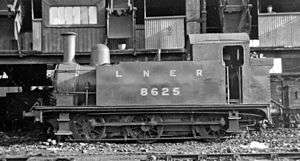GER Class S56
GER Class S56 (and R24 rebuilt)
LNER Class J69|

LNER 8625 (ex-7059, exx-GER 59) at Stratford locomotive depot, 28 September 1946 |
|
|
| Specifications |
|---|
| Configuration |
0-6-0T |
|---|
| UIC class |
C n2t |
|---|
| Gauge |
4 ft 8 1⁄2 in (1,435 mm) standard gauge |
|---|
| Driver diameter |
4 ft 0 in (1.219 m) |
|---|
| Wheelbase |
13 ft 10 in (4.22 m) |
|---|
| Length |
27 ft 8 in (8.43 m) |
|---|
| Loco weight |
42 long tons 9 cwt (95,100 lb or 43.1 t) |
|---|
| Fuel type |
Coal |
|---|
| Fuel capacity |
2 long tons 10 cwt (5,600 lb or 2.5 t) |
|---|
| Water cap |
1,200 imp gal (5,460 l; 1,440 US gal) |
|---|
Firebox:
• Firegrate area |
14.5 sq ft (1.35 m2) |
|---|
| Boiler pressure |
180 psi (1.24 MPa) |
|---|
| Heating surface |
996.17 sq ft (92.547 m2) |
|---|
| Cylinders |
Two, inside |
|---|
| Cylinder size |
16.5 in × 22 in (419 mm × 559 mm) |
|---|
|
|
|
|
|
The GER Class S56 was a class of 0-6-0T steam tank locomotives designed by James Holden for the Great Eastern Railway. Together with some rebuilt examples of GER Class R24, they passed to the London and North Eastern Railway at the grouping in 1923, and received the LNER classification J69.
History
The Class S56 were a development of the Class R24, being almost identical, apart from higher boiler pressure and larger water tanks. Twenty were built in 1904 at Stratford Works.
Table of orders and numbers[1]
| Year | Order No. | Quantity | GER Nos. | LNER Nos. | 1946 Nos. | Notes |
| 1904 | S56 | 10 | 51–60 | 7051–7060 | 8617–19, —, 8621, —, 8623, —, 8625–8626 | |
| 1904 | P57 | 10 | 81–90 | 7081–7090 | —, 8628–8633, —, 8635–8636 | |
|
All twenty passed to the LNER in 1923. Thirteen class J69 locomotives were lent to the War Department in October 1939,[2] of which five had been built as Class S56. They were sold to the War Department in October 1940,[3] where they were used on the Melbourne and Longmoor Military Railways.[2] The remaining locomotives were renumbered 8617–8636 in order of construction; however gaps were left where the locomotives sold to the War Department would have been. At nationalisation in 1948, the remainder passed to British Railways, who added 60000 to their number. Post-war withdrawals started in 1958, and by 1962 all had been retired.[4]
Table of withdrawals of S56-built locomotives[3][4]
| Year | Quantity in
service at
start of year | Quantity
withdrawn | Locomotives numbers | Notes |
| 1940 | 20 | 5 | 7054, 7056, 7058, 7081, 7088 | to WD 86, 87, 83, 80, 91 |
| 1958 | 15 | 5 | 68617, 68618, 68628, 68631, 68632 | |
| 1959 | 10 | 4 | 68625, 68629, 68630, 68636 | |
| 1960 | 6 | 1 | 68633 | |
| 1961 | 5 | 2 | 68619, 68623 | |
| 1962 | 3 | 3 | 68621, 68626, 68635 | |
|
Preservation
GER no. 87 (LNER 7087, 8633, BR 68633) has been preserved, initially at the Clapham Transport Museum,[5] and now at the National Railway Museum. It is currently on display at Bressingham Steam Museum.
References
- Aldrich, C. Langley (1969). The Locomotives of the Great Eastern Railway 1862–1962 (7th ed.). Wickford, Essex: C. Langley Aldrich. OCLC 30278831.
- Tourret, R. (1995). Allied Military Locomotives of the Second World War. Abingdon, Oxon: Tourret Publishing. ISBN 0-905878-06-X.
- Ian Allan ABC of British Railways Locomotives, part 4 (1948 ed.). pp. 49–50.
External links
|
|---|
| | Pre-grouping railway designs: | | |
|---|
| | |
|---|
| |
- D38
- D39
- D40
- D41
- D42
- D43
- D44
- D45
- D46
- D47
- D48
- G10
- J90
- J91
- Z4
- Z5
|
|---|
| | |
|---|
| | |
|---|
| | |
|---|
| | |
|---|
|
|---|
| | LNER designs: | |
|---|
| | Other designs: | |
|---|
| | Proposed designs: |
- P10 2-8-2T (Nov 1929)
- B 4-6-0 (Nov 1936)
- ? 4-8-2 (1939)
- Q 0-8-0 (June 1930)
- D 4-4-0 (1943)
- ? 4-8-4 (Feb 1946)
- ? 4-8-2 (Feb 1946)
- K 2-6-0 (Aug 1947)
|
|---|
| |
|
